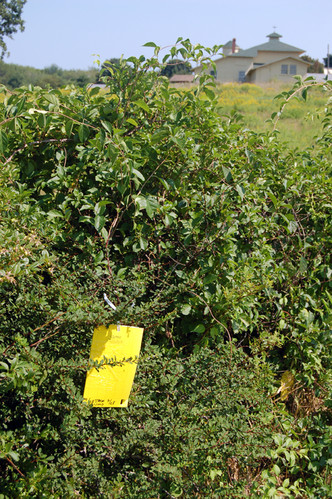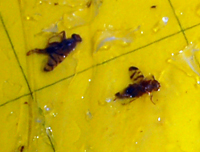The Wrack
The Wrack is the Wells Reserve blog, our collective logbook on the web.
The Wrack is the Wells Reserve blog, our collective logbook on the web.
 In the past couple of weeks, it's been hard not to notice the bright yellow plastic cards that have appeared in clumps of vegetation. Yesterday, I caught up with the guy who has been hanging and collecting them, field research entomologist Phil Stack. He filled me in; they are traps for catching fruit flies.
In the past couple of weeks, it's been hard not to notice the bright yellow plastic cards that have appeared in clumps of vegetation. Yesterday, I caught up with the guy who has been hanging and collecting them, field research entomologist Phil Stack. He filled me in; they are traps for catching fruit flies.
Phil was quick to point out he's looking for true fruit flies — not the kind hovering over your bananas. Those are in a different fly family, as Alex Wild points out on Myrmecos:
Drosophila is a member of the Drosophilidae, the vinegar or pomace flies. They are mostly fungivores, and their association with fruit is indirect: they eat the fungus that lives in rotting fruit. Some pointy-headed geneticist started using the wrong common name for them a century ago, and legions of geneticists unfortunately followed suit.
The true fruit flies, in the family Tephritidae, are "the most agriculturally important family of flies," according to the U.S. Department of Agriculture. Various species — there are about 5,000 worldwide — are known to be destructive, but some can be beneficial.
Phil is on a team led by Dr. Mary Rumpho, a plant physiologist and biochemist at the University of Maine, Orono. The team is doing field and lab research to understand the life history and ecology of a fruit fly associated with one of our least favorite invasives, the Japanese barberry (Berberis vulgaris).
The tephritid fruit flies being studied lay an egg in the seed of a barberry fruit. When the larva hatches, it feeds on one of the two seeds in the berry until it pupates and falls to the ground. The pupa overwinters in the soil and adult flies emerge the following spring or summer.
 Phil pointed out 4 tephritid fruit flies on one sticky trap that had been hanging for 5 days. He asked, "See that one with the patterned wings?" Indeed, it was easy to find; the Tephritidae are known for their often striking patterns and colors.
Phil pointed out 4 tephritid fruit flies on one sticky trap that had been hanging for 5 days. He asked, "See that one with the patterned wings?" Indeed, it was easy to find; the Tephritidae are known for their often striking patterns and colors.
The UMaine team will also be collecting barberry fruit samples for the lab, where they will germinate the seeds next spring to learn whether the second seed in host fruits is still capable of growing a new barberry plant.
Even if the fruit flies are found to destroy the viability of individual barberry fruits, it is probably too much to expect the fruit flies to offer an effective biological control against the very well established scourge, Berberis vulgaris.